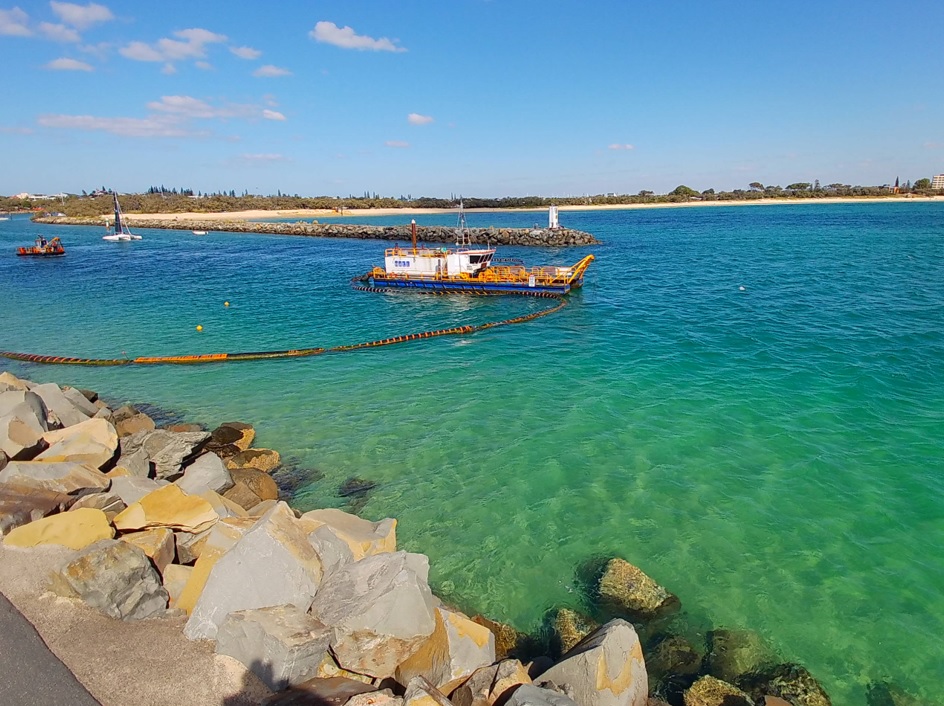Mooloolaba boat harbour dredging
The Mooloolaba harbour and entrance training walls were built in the late 1960's. Since that time, sand shoaling events have occurred periodically in the entrance channel.
Maintaining a safe navigable entrance to the Mooloolaba Boat Harbour at all times is crucial for all boaties. We aim to maintain the boat harbour entrance clear to a design depth of at least -2.5m Lowest Astronomical Tide (LAT) at all times.

Channel shoaling
During a shoaling event, sand accretes to form a shoal (like a sand bar). This shoal reduces the water depth, making navigation more hazardous. During these shoaling events, a conveyor belt of sand runs along the headland and feeds the entrance shoal.
Dredging activities are carried out to improve the safety of the boat harbour entrance. These activities involve removing the sand shoal by pumping the sand onto Mooloolaba Beach. The dredge stays in position and continues to remove sand until safe depths are reached.
In the past, shoaling events were infrequent, occurring every few years, with intervals of 3-5 years or longer. In the last 10-15 years shoaling events have become more frequent. The most recent shoaling event, which took place from February 2022 to June 2022, required continuous dredging and had a significant impact on navigational access.
An additional challenge is the wave conditions that tend to drive sand into the entrance. This greatly impacts vessel navigation as well as impacting the ability to safely undertake dredging activities to remove the hazard.

Current dredging strategy
Local Sunshine Coast contractor, Hall Contracting, are currently contracted to dredge the channel entrance.
This arrangement allows a dredge to be available on short notice, with cost effective establishment and standby rates. A small cutter suction dredge is used, as this plant is manoeuvrable and small enough for boaties to pass safely whilst in use and maximises time on task through a shallow vessel draught.
Some stakeholders have suggested that a bigger dredge would be better, however this is not the case. The small dredge has a smaller draught and is less likely to hit the bottom of the channel and damage either the dredge or its cutters/suction points. The smaller dredge also dredges from the calmer waters outwards rather than a larger dredge operating from seaward into the channel where it is constantly exposed to ocean swells. This approach helps ensure a safer and more stable operation. The smaller dredge is also has the ability to use fitted pipelines to assist in replenishing sand on Mooloolaba beach.
A permanent pipeline was installed in 2013 along the eastern breakwater wall and runs across the channel anchored on the riverbed. The dredged sand is pumped onto Mooloolaba Beach by the pipeline that runs under the beach. This makes dredging more efficient with less impact on boaties accessing the harbour.

Current dredging work
Western channel trial
The dredging contractor mobilised to the site at the end of November 2022 to undertake a trial dredging program. This trial dredging program involves dredging sand banks to the west of the Mooloolaba rock wall, as well as dredging to a deeper depth than normal to see if this assists with longer term shoaling mitigation. This approach is different to previous programs which involved just dredging the entrance channel.
Outcomes of this trial will determine if there is improved access during shoaling events by widening of the channel to the west. Feedback from the local Stakeholder Reference Group helped developed this concept. This group was formed by Maritime Safety Queensland to provide local advice and to help investigate long-term solutions for the Mooloolaba Boat Harbour entrance.
The trial works were completed in late-March.
Hydrographic surveys
Hydrographic surveys continue to be carried out by MSQ regularly to monitor depths in the entrance channel.

Entrance monitoring cameras
In July 2021, we installed cameras to monitor the wave conditions and dredging activity at the channel entrance. The cameras are fixed to the 2 towers at the end of each Mooloolaba breakwater, looking down into the channel. A photo is taken every 15 minutes.
Mooloolaba Harbour entrance long-term solution
A long-term solution to maintain safe navigable access at the Mooloolaba Harbour entrance is currently being investigated. For more information about our investigations into the breakwater, visit Mooloolaba Boat Harbour entrance, long-term solution.
Mooloolah River entrance bar
Boaties are reminded that coastal bars are constantly changing. Plan your crossing of the Mooloolah River entrance bar and navigate with caution.
The Mooloolah River entrance is a coastal bar. This means that each person on board an open boat less than 4.8m in length must wear an appropriate lifejacket while crossing the coastal bar.
Stay up-to-date with the latest Notice to Mariners advice to see if your crossing will be impacted.

